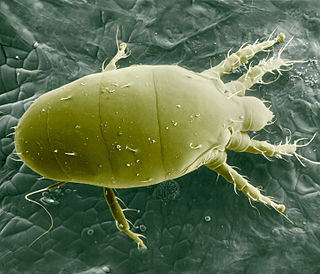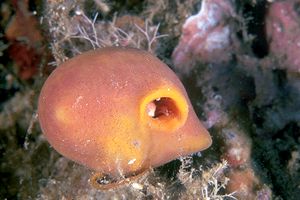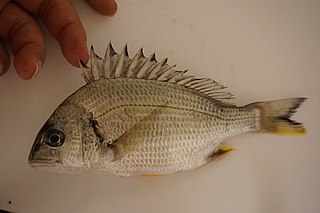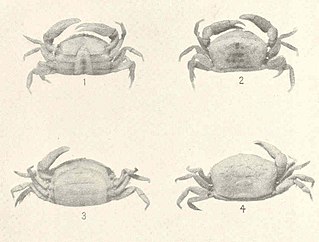
Slipper lobsters are a family (Scyllaridae) of about 90 species of achelate crustaceans, in the Decapoda clade Reptantia, found in all warm oceans and seas. They are not true lobsters, but are more closely related to spiny lobsters and furry lobsters. Slipper lobsters are instantly recognisable by their enlarged antennae, which project forward from the head as wide plates. All the species of slipper lobsters are edible, and some, such as the Moreton Bay bug and the Balmain bug are of commercial importance.

The broad mite, Polyphagotarsonemus latus, is a microscopic species of mite found on many species of plants, spanning 60 families including important agricultural species such as cotton, soybean, blackberries, strawberries, peppers, and other fruits. Broad mites are also currently affecting cannabis plants, as the industry matures with legalization. The mites are found in many areas worldwide and are major greenhouse pests.

Suberites domuncula is a species of sea sponge belonging to the family Suberitidae.

The horse-eye jack, also known as the big-eye jack, is a game fish and minor commercial fish in the family Carangidae. Its appearance is similar to that of the crevalle jack, although the horse-eye jack's head is not as blunt. The horse-eye jack is known to feed on smaller fish and on many invertebrates, such as shrimp and crab.
Cathrine Tuivaiti is a netball international who has played for Samoa, New Zealand and Tonga. She represented Samoa at the 2006 Commonwealth Games and the 2007 World Netball Championships, New Zealand at the 2014 Commonwealth Games and Tonga at the 2023 Netball World Cup. During the National Bank Cup era, she played for Northern Force. During the ANZ Championship era, she played for Northern Mystics. She subsequently played for Central Pulse, Adelaide Thunderbirds, Strathclyde Sirens and Severn Stars. In 2022, she was included on a list of the 25 best players to feature in netball leagues in New Zealand since 1998.

Acanthopagrus latus, the yellowfin seabream, grey bream, Houttuyn's yellowfin seabream, Japanese bream or yellow-finned black porgy, is a species of marine ray-finned fish belonging to the family Sparidae, the seabreams and porgies. This fish is found in the Western Pacific Ocean.

Scyllarides latus, the Mediterranean slipper lobster, is a species of slipper lobster found in the Mediterranean Sea and in the eastern Atlantic Ocean. It is edible and highly regarded as food, but is now rare over much of its range due to overfishing. Adults may grow to 1 foot (30 cm) long, are camouflaged, and have no claws. They are nocturnal, emerging from caves and other shelters during the night to feed on molluscs. As well as being eaten by humans, S. latus is also preyed upon by a variety of bony fish. Its closest relative is S. herklotsii, which occurs off the Atlantic coast of West Africa; other species of Scyllarides occur in the western Atlantic Ocean and the Indo-Pacific. The larvae and young animals are largely unknown.
Scyllarides herklotsii is a species of slipper lobster from the Atlantic coast West Africa. It is edible, but is not commercially fished, and is taken only by accident.

Arvelius is a genus of stink bugs in the family Pentatomidae. There are about 13 described species in Arvelius.
Chrysosyrphus latus , the Variable Wrinklehead, is a rare species of syrphid fly observed in the eastern United states and widespread in Canada. Hoverflies can remain nearly motionless in flight. The adults are also known as flower flies for they are commonly found on flowers, from which they get both energy-giving nectar and protein-rich pollen. The larvae are unknown.
Platyceroides is a genus of stag beetles in the family Lucanidae. There are about 16 described species in Platyceroides.
Ametor is a genus of water scavenger beetles in the family Hydrophilidae. There are at least two described species in Ametor.

Emblethis is a genus of dirt-colored seed bugs in the family Rhyparochromidae. There are more than 30 described species in Emblethis.
Cryphocricos is a genus of creeping water bugs in the family Naucoridae. There are about 15 described species in Cryphocricos.
Platyceroides latus is a species of stag beetle in the family Lucanidae. It is found in North America.
Ametor scabrosus is a species of water scavenger beetle in the family Hydrophilidae. It is found in North America.
Ipelates latus is a species of primitive carrion beetle in the family Agyrtidae. It is found in North America.
Ipelates is a genus of primitive carrion beetles in the family Agyrtidae. There are at least four described species in Ipelates.

Pachycheles is a genus of porcelain crabs in the family Porcellanidae. There are more than 40 described species in Pachycheles.

Dissodactylus is a genus of pea crabs in the family Pinnotheridae. There are at least 20 described species in Dissodactylus.








